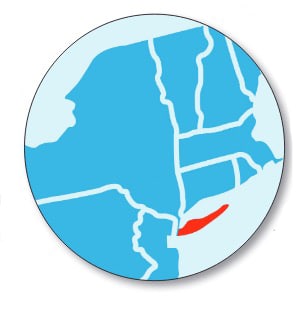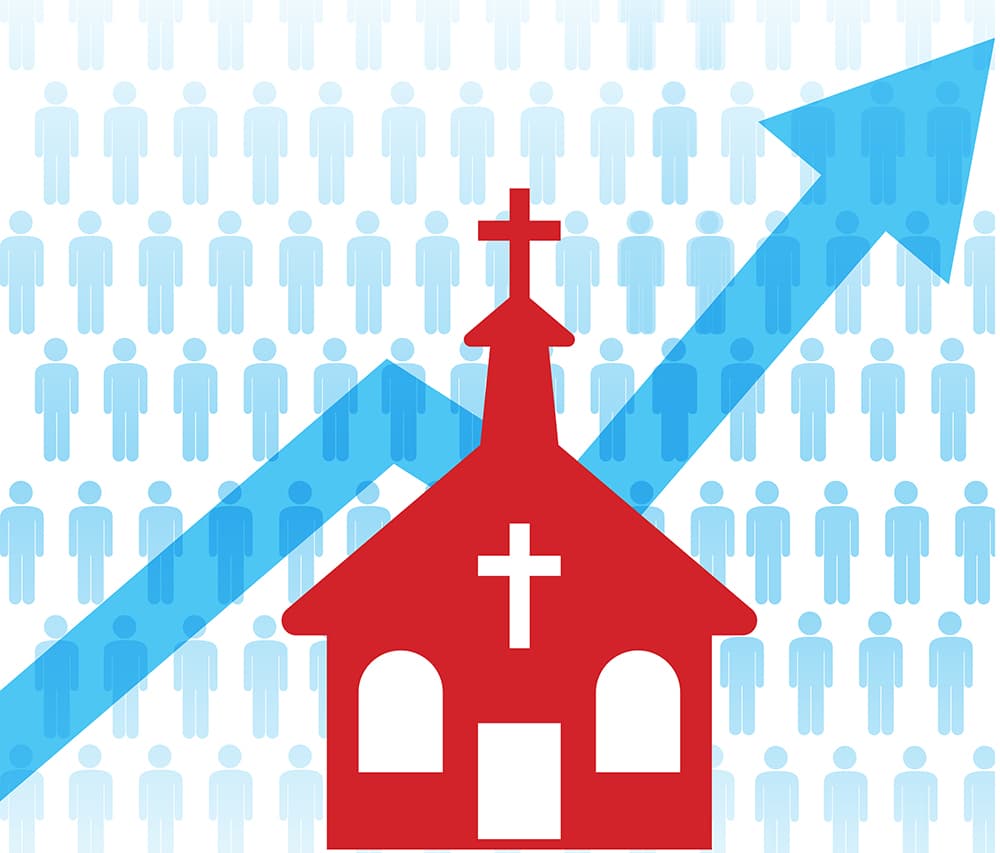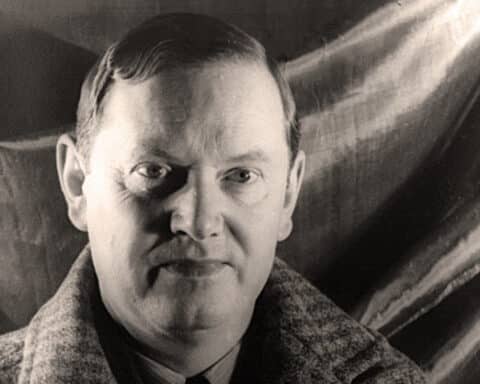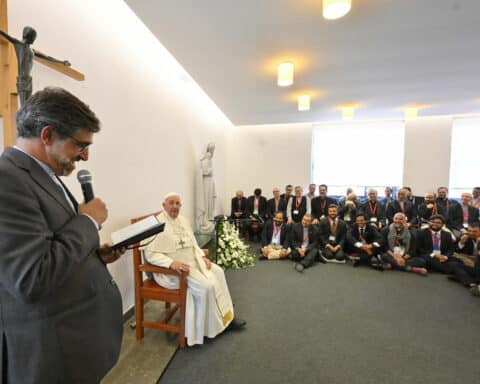As Catholics in the U.S., it’s impossible to ignore the statistics. For decades, participation in the Church has been shrinking. More U.S. Catholics have fallen away: In a 2018 survey from the Center for Applied Research in the Apostolate at Georgetown University, 26.1 million said they were raised Catholic but no longer identify with the Faith. Parishes are understaffed, with fewer priests: 36,580 in 2018 compared with 59,192 in 1970. Compared to the vibrant U.S. Catholic communities in the late 19th and early 20th centuries — largely influenced by the influx of immigrants from Catholic countries such as Ireland, Italy and Poland — dioceses have struggled to maintain their numbers.
Still, some dioceses across the country are defying statistics. There is an unquestioned demographic shift happening in the Catholic Church in the United States. Traditionally, the centers of Catholic life were cities like Boston and New York, Chicago and Detroit. In recent decades, however, much has changed. While some parts of the Northeast and Midwest have retained large numbers of Catholics (though fewer and fewer of them attend Mass regularly), the new vibrant centers of American Catholicism are in the South and the Southwest. Many dioceses in these areas are experiencing a veritable explosion in the number of Catholics — in many cases exceeding a million total people — causing them to need new parishes and new schools.
In this article, Our Sunday Visitor presents four of the largest dioceses across the country — one in the Northeast and three in the South and Southwest — that give hope for the future of the Church in the United States.
Diocese of Rockville Centre, New York
 The Diocese of Rockville Centre covers Long Island in New York. Located in one of the traditional Catholic centers of the United States, the diocese was formed in 1957 out of territory in the Diocese of Brooklyn. It is the eighth-largest diocese in the U.S., including archdioceses. There are almost 1.5 million Catholics in the diocese out of a total population of almost 3 million people within diocesan boundaries.
The Diocese of Rockville Centre covers Long Island in New York. Located in one of the traditional Catholic centers of the United States, the diocese was formed in 1957 out of territory in the Diocese of Brooklyn. It is the eighth-largest diocese in the U.S., including archdioceses. There are almost 1.5 million Catholics in the diocese out of a total population of almost 3 million people within diocesan boundaries.
There are 133 parishes, one college parish and 392 priests in active ministry (208 incardinated in the diocese, 107 externs and 62 priests from religious orders). There are also 801 religious sisters, 34 religious brothers and 285 permanent deacons.
According to the diocesan website for 2018, there were more than 15,000 people in total received into the Church (including infant baptisms and adults entering through the Rite of Christian Initiation for Adults), more than 13,600 first Communions, more than 14,700 confirmations and almost 3,000 marriages.
The diocese recently created an Office of Parish Evangelization and Pastoral Planning in 2018 to drive dramatic missionary growth. In addition, the many ministries and resources offered by the diocese provide the laity with tools to participate in this evangelization and deepen their own spiritual lives.

The diocese hosts a 24-7 television station called Catholic Faith Network that reaches 1.5 million homes. This station broadcasts daily Mass, a daily Rosary, the Divine Mercy Chaplet, shares Church news and includes special segments, such as conversations with Cardinal Timothy M. Dolan of the neighboring Archdiocese of New York. They also have two print publications: The Long Island Catholic Magazine and their Spanish-language newspaper, Fe Fuerza Vida.
For adult Catholics, the diocese offers a School of Missionary Disciples, a two-year program that provides personal, intellectual, spiritual and pastoral formation. About 10-15 people make up each two-year class, and they come from a wide range of ages and walks of life. Those in the program take a deep look at Scripture and the teachings of the Church, giving them the knowledge and tools to be missionary disciples in their communities.
| What is the largest parish in America? |
|---|
|
Another example of stunning growth can be found in the state of North Carolina. The combined number of Catholics in the state’s two dioceses — Raleigh and Charlotte — has grown from around 200,000 to around 420,000 in just 20 years. In South Carolina, the statewide diocese of Charleston has seen 10 new parishes established in the last 20 years, and the number of permanent deacons has doubled. The Charlotte diocese is home to the largest parish in the United States: St. Matthew, on the southside of Charlotte. In about 30 years, the parish has grown from 237 families to over 10,000 registered households. Established in 1986, parishioners first met in a borrowed movie theater for Mass until buildings were constructed. Now they have three buildings in which to celebrate Mass: the main sanctuary (which seats 2,000 people), a school gym and a south campus building about 15 minutes away. In order to meet the needs of all parishioners, St. Matthew’s has a strong focus on small groups, and over 100 ministries are offered. They also conduct regular surveys through Gallup and the Center for Applied Research in the Apostolate (CARA) to evaluate where the parish is thriving or struggling. |
Diocese of Dallas

One rapidly growing diocese in Texas is the Diocese of Dallas. While it was first established in 1890, the diocese split in two in 1969, creating the Diocese of Fort Worth to the west. Since then, the Dallas diocese has grown at a prolific rate. In 1990 there were 226,129 Catholics in the diocese; today there are around 1.3 million.
There are a number of factors that account for this growth, according to Annette G. Taylor, director of communications for the Diocese of Dallas. “Numerous corporations have moved into the nine North Texas counties that make up the Diocese of Dallas since the 1980s,” Taylor said. “Many of those relocations brought many Catholics from the East Coast.”
“The diocese has also experienced great growth from the arrival of immigrants from south of the border,” Taylor said. Immigration from Mexico and Central America continues to increase the number of Catholics in the region, as those countries have high percentages of Catholics in their populations.
Taylor also attributes growth to the strong sense of church community that exists in Texas as part of the Bible Belt. All denominations, not just Catholics, she said, see a church community as an important part of their culture.

The rapid growth of the diocese causes some logistical problems. The primary issue, according to Taylor, is the need for more priests. “We have 220 priests. That includes religious-order priests, like the Jesuits and Cistercians, who teach at their schools and are not assigned to parishes,” she said. Serving more than a million Catholics, this means there is one priest for every 6,000 Catholics.
Within the Dallas diocese, there are 74 parishes and 36 Catholic schools. “This makes it a large territory and Catholic community to cover and reach,” said Taylor. “Vocations numbers are growing, but the need is still tremendous. Also, the wide divide in the socioeconomic makeup of the diocese is a challenge.”
While the number of priests provides a challenge, there has been a boom in one area of vocations. “We have a strong diaconate,” Taylor said. “There are 140 deacons in active ministry, who are a tremendous blessing to our priests, parishes and people.”
There is another problem that Taylor sees as a sort of a blessing. “The need exists to build additional churches and Catholic schools,” she said. “That’s a good problem to have, and not one that I think dioceses in other parts of the country might have.”
The size and location of the Diocese of Dallas has fostered a rich diversity of nationalities and cultures and a strong, faithful group of Catholics, according to Taylor. This helps bring home the sense of catholicity and universality.
| Permanent Diaconate |
|---|
 One characteristic that each of these dioceses have is the large interest and response to the permanent diaconate. In 1967, Pope Paul VI reestablished the permanent diaconate in the Latin rite Church, publishing his apostolic letter Sacrum Diaconatus Ordinem. This motu proprio recalled the role of deacons in the early Church and examined how deacons can serve in the Church today, and their place in the ecclesial hierarchy. Deacons are ordained and share in the sacrament of holy orders, but they are not priests or bishops. They can perform some sacraments, such as marriage and baptism, and they assist priests and bishops in teaching the faithful. Permanent deacons can be married; in fact, the majority (92%) are married and over the age of 50 (96%), according the 2018 study by the Center for Applied Research in the Apostolate at Georgetown University. This same study lists the dioceses with more than 200 active and inactive permanent deacons: The Diocese of Rockville Centre was fifth (334 total deacons) and the Diocese of Phoenix was 10th (270 total deacons), each averaging about one deacon for every 4,000-4,500 Catholics in the dioceses. |
Diocese of Phoenix

The Diocese of Phoenix was established out of the territory of the Diocese of Tucson. When it was established, the Catholic population was around 200,000. The rapid growth of the diocese largely can be attributed to an influx of immigrants from Latin America, the Philippines and elsewhere.
The growth continues today. Last year, to respond to the growing needs of the faithful, the diocese launched its first-ever $100 million fundraising campaign. Some of the intended uses for raised funds include supporting the diocese’s parishes, Newman Centers, Catholic schools, tuition for Catholic students, seminarian education, retired priests and more.
One of the more remarkable aspects about the facts and figures of the state of the diocese is the increasing number of permanent deacons. “We have a good number of deacons for a variety of reasons,” said Deacon Doug Bogart, associate director of education and formation for the Office of the Diaconate. The Diocese of Phoenix was one of the first dioceses in the United States to adopt the permanent diaconate after it was restored at the Second Vatican Council, so Deacon Bogart claims it has “a rich history of men stepping forward for this vocation.”
A large number of these deacons have moved from other places, having been ordained in other dioceses. “With the strong economy and plenty of sunshine, lots of folks want to move here, and that number includes deacons as well,” Bogart said.

As with most dioceses, Phoenix still has a great need for more clerics — both deacons and priests. The rapid growth of the diocese has made this a more pressing issue. “Under Bishop Thomas J. Olmsted’s leadership, the Catholic faith is strong and vibrant here, and good men naturally respond to give of themselves in service,” Deacon Bogart said. “Bishop has made a real commitment to solid adult catechesis through the Kino Catechetical Institute, and so men are able to learn and fall deeper in love with their faith.”
The Kino Catechetical Institute is an adult faith-formation program which provides “foundational formation in Catholic doctrine, equipping the laity to respond to Christ’s call to discipleship,” according to their website. They specifically offer programs for Catholic school teachers, catechists, aspiring deacons and anyone interested in learning more about the Faith.
“When they do this,” Deacon Bogart continued, “many are drawn to a more committed desire to serve and inquire about the diaconate.”
The diocese currently has 22 men in formation for the permanent diaconate, with another 30 applying. This is just one sign of the phenomenal growth and vibrancy of the Church in the Diocese of Phoenix.
Diocese of Orange

“The faithful of our diocese are good stewards, providing engagement in their parishes and ministries and showing heartfelt generosity to the calling for financial support,” said Hank Evers, director of strategic communications for the Diocese of Orange. “Our annual Pastoral Services Appeal continues to grow year over year, and our For Christ Forever capital campaign was a major success, having raised $127 million from an estimated 28,000 families.”
The 1.6 million Catholics of Orange populate 62 parishes and Catholic centers served by 270 priests and 141 deacons. In addition to the 282 religious sisters in the diocese, there are 34 Catholic elementary schools and seven Catholic high schools that serve 18,520 Catholic students. More than 24,000 children are enrolled in parish religious-education classes.
As a sign of a large, growing and vibrant diocese, Orange provides many ministries to give community members opportunities to connect with the Church. These ministries include those to the deaf community, immigrants, Catholics struggling with same-sex attraction, the imprisoned, those with special needs and many more.
While the Diocese of Orange may only be a few decades old, Catholicism has been in the area since 1776, when St. Junipero Serra founded the Mission San Juan Capistrano. The Spanish and Latin American presence in the diocese has only increased in the intervening centuries, and there recently has been an influx of immigrants from Vietnam and the Philippines, which has caused the Catholic population to grow dramatically.
There has been at least one tangible result of the Diocese of Orange’s rapid growth: the transformation of the former Crystal Cathedral. On July 17, the diocese completed a multi-year renovation after it was purchased from the Reformed Church in America. It is now officially dedicated as Christ Cathedral.

“This is a response to the growth and engagement of our diocese,” Evers said. “If Crystal Cathedral had not been available for a remarkably low price when it was in bankruptcy, we would have spent even more designing and building a new cathedral to manage the significant growth of our diocese.” The diocese had been looking to build a larger cathedral for some time due to the diocese’s growth, and bought the Crystal Cathedral for $57.5 million in 2012.
Msgr. Stephen Doktorczyk is vicar general and moderator of the Curia for the Diocese of Orange. Ordained in 2005, he has witnessed the life of the diocese firsthand. According to Msgr. Doktorczyk, the diocese’s Catholic population may not be increasing rapidly, but it is “holding its own,” and has a certain significant vibrance.
As of the end of 2018, there were more than 1.6 million Catholics living in the diocese. Msgr. Doktorczyk hopes that the diocese becomes a center for Catholic pilgrimage in the near future. There is also a community of the Norbertine order, and they are building a new abbey, which will open within the next couple of years. Msgr. Doktorczyk hopes that these will attract Catholics to the area — and having Disneyland in their backyard doesn’t hurt, either.
“[Pilgrimage] revives people,” he said. “When people see someone coming in and being excited about the Church, traveling just to experience the Church in a particular way, it can revive and invigorate their faith.”
“God only knows” what the future will hold for the Diocese of Orange, Evers said, “but we are grateful that our parishes remain strong and vibrant with highly engaged parishioners.” This is how the diocese has flourished, and how it will continue growing and serving the people of God moving forward.
Paul Senz writes from Oregon.
| St. Junipero Serra |
|---|
|
Born on the Spanish island of Majorca in the early 1700s, he moved to Italy and become a Franciscan, where he taught at the University of Padua. When Brother Junipero was 37, he arrived in Mexico City to begin his missionary work in the Americas. During his journey, his leg became infected by an insect bite, which was painful and made it difficult to walk. This wound affected him the remainder of his life. During this time, he founded multiple missions along the West Coast and converted thousands of indigenous peoples, learning their native language and teaching them skills, such as agriculture, and developing regional commerce. Pope John Paul II beatified Junipero Serra in 1988, and he was declared a saint by Pope Francis in 2015. His feast day is July 1. |


 St. Junipero Serra was one of the great missionaries to the New World, evangelizing large regions of what is now California.
St. Junipero Serra was one of the great missionaries to the New World, evangelizing large regions of what is now California.


